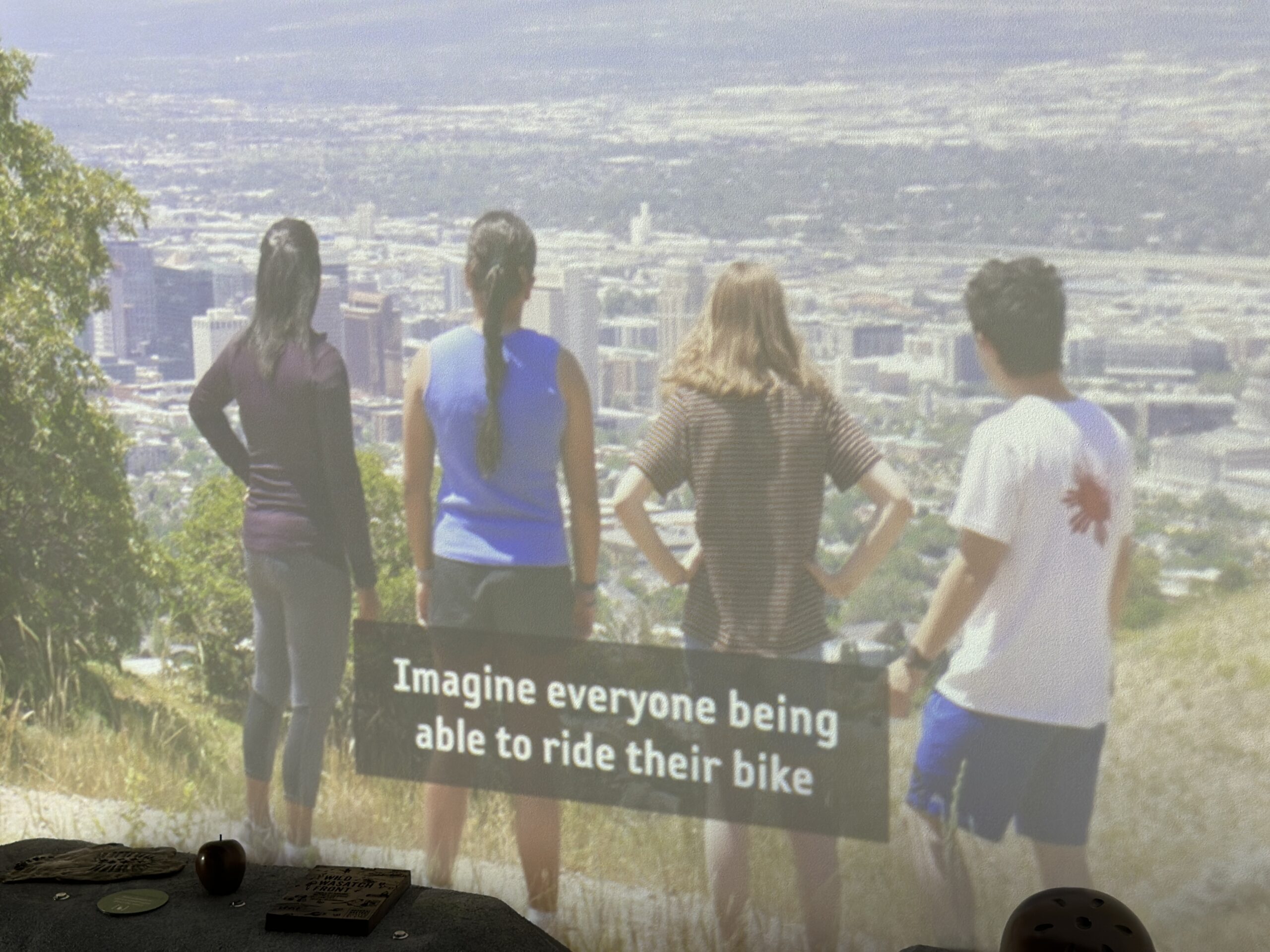
The new Climate of Hope exhibit at the Natural History Museum of Utah offers museum visitors a more localized and solutions-oriented framing of climate change than other exhibits have done in past years. In this episode, exhibit developer Lisa Thompson and Lynne Zummo, the curator of Learning Sciences at NHMU, take us through the interactive exhibit where they are gathering important data that may improve communication techniques and strategies in years to come.
Listen to the Interview:
Transcript:
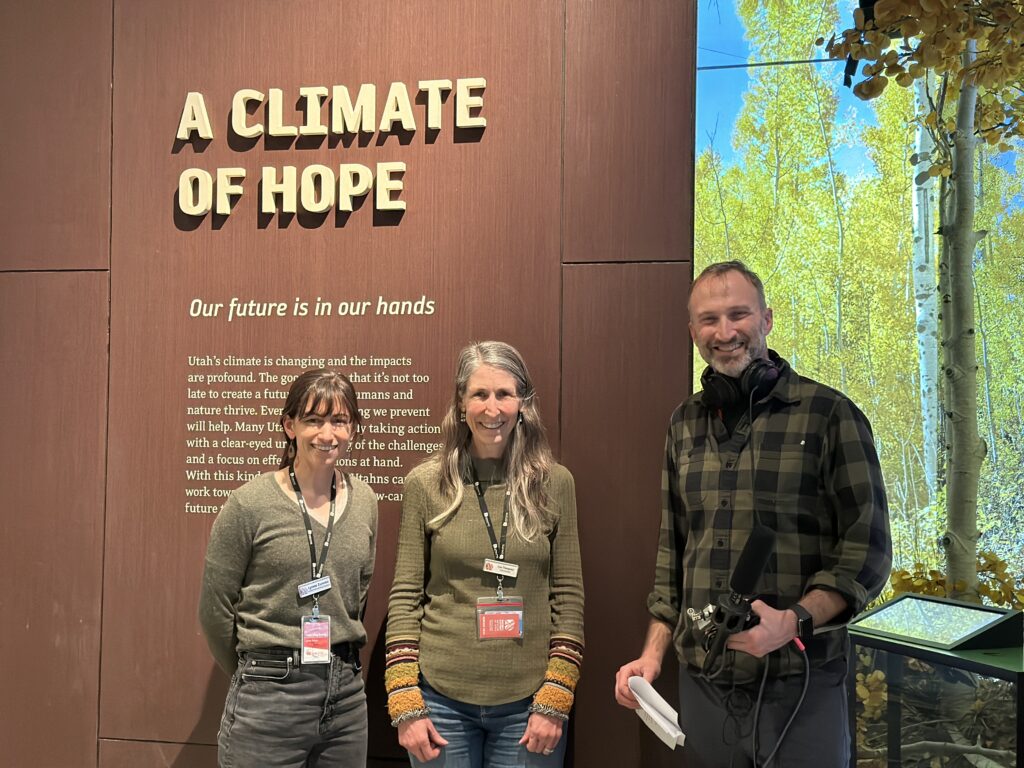
Okay. So, we’re recording and Lisa Thompson and Lynne Zummo. Did I get your name right? So great to see you. Thank you for making time to meet with me today. And before we start, can each of you just give you a quick introduction? Like, what is your affiliation here with the Natural History Museum of Utah?
Lisa Thompson
So, this is Lisa, and I’m an exhibit developer. I work on the content and storytelling side of exhibits.
Lynne Zummo
And I’m Lynne here at the Natural History Museum of Utah. I’m the curator of Learning sciences. So, I do research on how people learn, and much of my research happens in exhibits where people are learning. And I also have joint appointment with the educational psychology department as an assistant professor of Learning Sciences.
Ross Chambless
Okay, very cool. Very interesting. Okay, so I have not experienced this exhibit yet. I’ve been to this museum many times. I have to say it’s probably one of my most favorite places in the whole state. And I try to come here as much as I can, but other than just knowing that we’re on the fifth floor of the museum, can you kind of paint a picture as far as what we’re what we’re looking at here? Where are we in this in the context of this new exhibit?
Lisa Thompson
Yes. So, one of the things that we’re proudest of in the exhibit is the way that it starts. It starts in an aspen grove. So, you’re going to be immersed in a 360-degree Aspen Grove experience. And there are real aspen trees in it. There’re projections. There are Aspen leaves on the floor, and you’re going to be asked a question, which is how do you feel when you think about the changing climate in our future?
Ross Chambless
All right. Or should we walk in there and see what that’s like? So, now we’re in the Aspen Grove. Can talk about why you chose to make this sort of the entry way into the exhibit?
Lisa Thompson
Sure. So, one of the things that we wanted to do was create a different kind of climate change exhibit. In the past, climate exhibits often had a pretty doom and gloom message, a real sense of urgency, and a dark vision of what the future might be like. They also tended to focus on places that were far away. Like maybe we’re looking at the Arctic polar bears in the Arctic, and they also tended to be really data heavy, lots of charts and graphs for people to look at. And we know from climate change communication research that none of these approaches are particularly effective. And so, we wanted to ground the exhibit here in a place that feels like Utah and that feels beautiful and welcoming, and that also would give people a chance to express their emotions and acknowledge that emotion is a really important part of how we think about and how we feel motivated to act on climate change.
Ross Chambless
Yeah, interesting. Any additional thoughts on that?
Lynne Zummo
Yeah, I think sometimes learning experiences about climate change and even conversations about climate change aren’t necessarily inviting to a lot of people. They’re not, they don’t sound fun, they don’t sound appealing. But by starting off with this Aspen Grove, which is a beautiful experience, we have a chance to pull people in and to invite a lot of people into the conversation who maybe haven’t been taking part in that conversation before.
Ross Chambless
Yeah. Interesting. So now that once you’ve got me the visitor in the Aspen Grove, it looks like you’re asking me to answer some different some questions, I guess was sort of an assessment of how I’m feeling today. So, okay, so tap to begin.
Lisa Thompson
Yeah. So, you’re presented with 11 different emotions here. Is there one that that feels authentic to you today about how you’re feeling when you think about the changing climate?
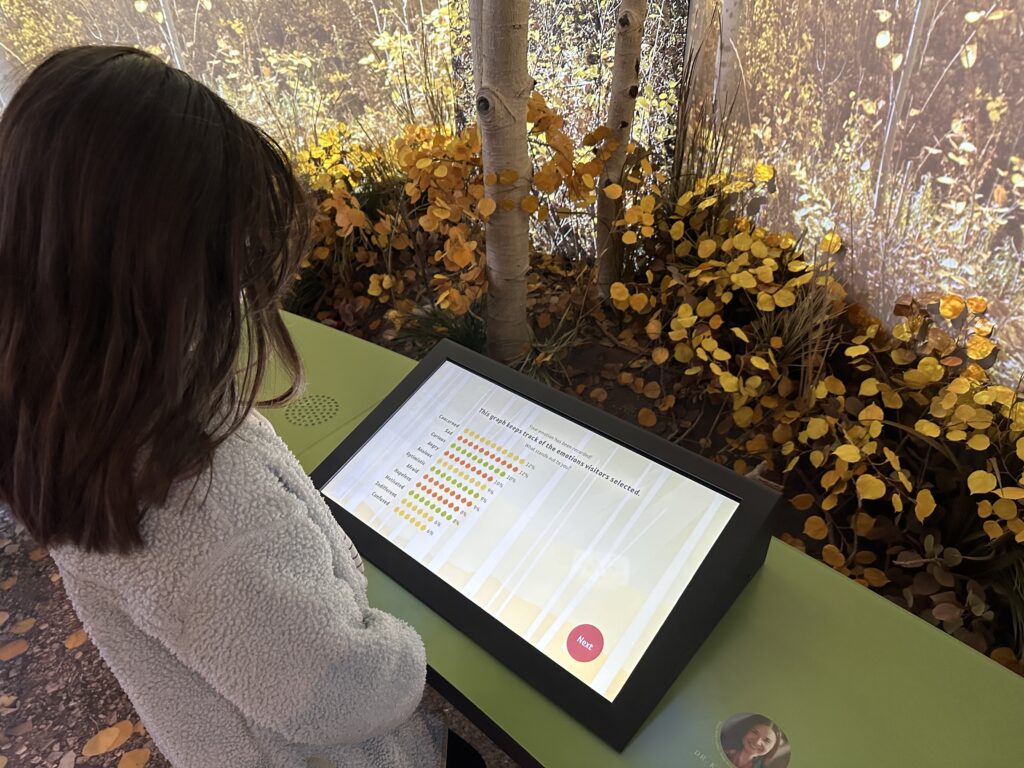
Ross Chambless
Yeah. So, I see concerned, confused, motivated, sad, afraid, hopeless, optimistic. I think I would probably just say I’ll say concerns.
All right. And now it’s the leaves have shuffled a little bit and now it says watch the grove in front of you. Oh, interesting. And it’s sort of changing. And I see something like maybe snow or leaves coming down.
Lisa Thompson
So, when you choose an emotion and send it into the grove, we wanted the grove to react in some way to the emotion that you sent into it. But then when you look back down at the screen, you get to see that other people share the same emotion that you have and see that our community actually feels many different emotions.
Ross Chambless
Fascinating. So yeah, I see I see kind of a list of the types of emotions that people chose. And the one I chose “concerned” looks like it’s at 12%, which is tied with “Sad” is as one of the most chosen emotions.
Lisa Thompson
Right. And we know that most people may not feel hopeful when they come into the exhibit, but we hope that this exhibit provides them a path toward feeling more hopeful about climate change in the future.
Ross Chambless
Interesting. So, this is kind of a way of gathering data, though, right?
Lynne Zummo
It is, yes. We are collecting back-end data on this so we can see what people choose over time and whether that might be correlated with certain events or certain times of the year. We haven’t actually looked at that data yet, but I’m looking forward to digging into it at some point.
Ross Chambless
Yeah, interesting. And you’re capturing this data at the very beginning, sort of how they’re coming, what mindset they are when they’re coming into it before they’ve even really seen the exhibit?
Lynne Zummo
Ideally, yes, we do hope that people start here, and we think that the Grove is an inviting space to pull people in. We recognize that some people may be coming from the other the other entrance. So, they might have seen part of the exhibit already.
Ross Chambless
Yeah. Interesting. Well, and you mentioned kind of already, Lisa, that you’ve looked at some other exhibits in other places that were taking approaches that probably just weren’t effective. Like you said, there were too much data. And there is just kind of the message was a bit doom and gloomy. But I’m wondering, coming into this exhibit, it seems like you approached it with a lot of intentionality as far as trying to localize it and just approach a very different kind of message, overall?
Lisa Thompson
Yeah, our objective was to look at climate communication research and understand what hadn’t been working in the past and also the types of messaging that was proving successful often in other contexts, often in a more conversational context. And so, our goal was to see, well, can we translate some of these techniques into an exhibit experience? And that’s what Lynne is going to find out and see.
Ross Chambless
Okay, very cool. Should we keep walking out of the out of the grove?
Okay, so now what are we looking at?
Lisa Thompson
So, the next section of the exhibit is about impacts that we are experiencing here and now in Utah. And so, one of the frames we talked about that doesn’t particularly work well is talking about things that are distant in time and place because it makes them feel not very personally relevant to people. And so, we wanted to ground the impact section and things that are here in now, but also not make it like the world is burning down and everything is coming to an end. But we tried to choose examples that are relatable that people, things that people would experience from in their own lives, and have some fun examples to share… well, “fun”… interesting, let’s say. For example, for the idea of shorter, warmer winters, we use a photograph of people ice skating on Liberty Park Pond, which used to be something people did every winter, but now just really seems impossible to imagine.
Ross Chambless
Right. I’m just curious from your data going into this that most visitors to the Natural History Museum of Utah are locals, are from Utah? Did that help to shape your approach to this exhibit?
Lynne Zummo
Definitely. And this is the Natural History Museum of Utah, so we wanted to stay specific to Utah places and Utah people. We do from our data collection so far, we do get quite a few people who are from out of state and even out of the country. But what we’re finding very, very preliminarily is that even though this space in particular is so grounded in Utah, people who are from elsewhere use it as a chance to connect with the natural landscapes with where they’re from. So, for instance, a visitor who is from Florida went through this section and he kept pointing out to things that he saw in Utah but could relate them to changes he was seeing in Florida. So, to specific species he knew and other connections to landscapes that were familiar to him.
Ross Chambless
Okay. I just wanted to welcome to the conversation, Margaret Call. Hey, Margaret.
Margaret Call
Hey, thanks for having me.
Ross Chambless
Thanks for joining us. And I would welcome you to give your input also to whatever we’re talking about as we go through the exhibit, just from your experience as a docent, right?
Margaret Call
Yeah, I help volunteer as a gallery interpreter in here.
Ross Chambless
Okay. Gallery interpreter. Wonderful. Okay, so what would you like me to see? Maybe a space within this section that maybe pertains to your research or your what you’re working on?
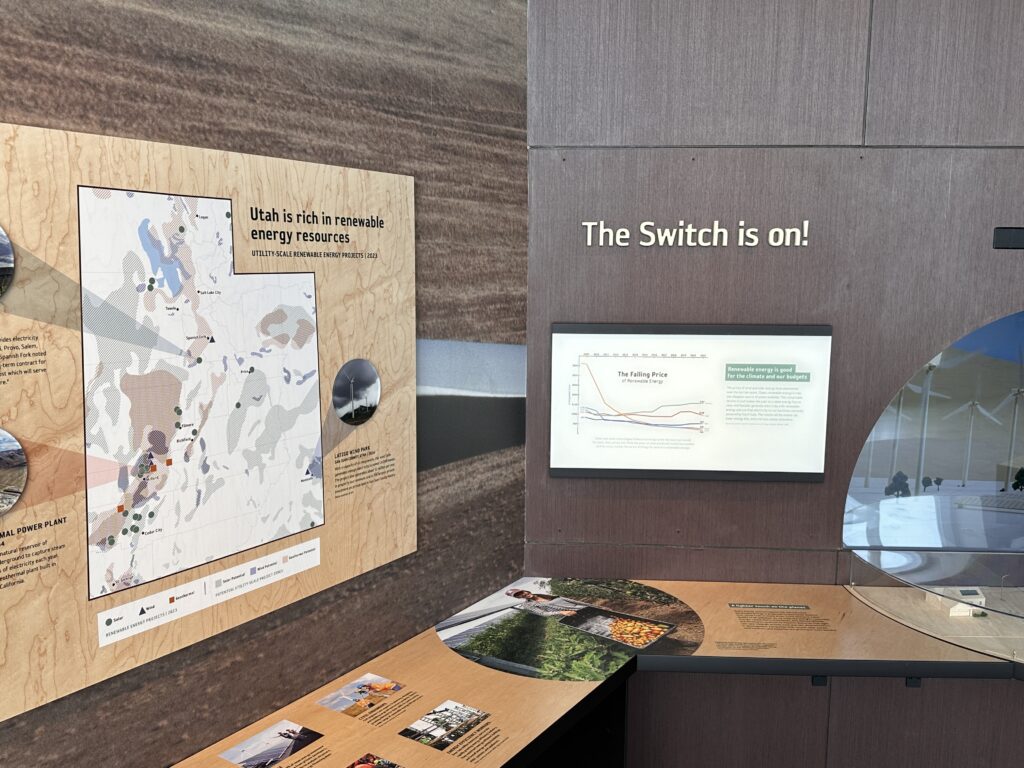
Lynne Zummo
Well, so one interactive that I think is really special and interesting in this section is right over here. It’s a digital story and it’s a scrolling story. And you scroll through it with a wheel that actually turns and it tells the story of how climate change is impacting health and human health in Utah and specifically in the Salt Lake Valley. And it tells it through a lens that’s a bit whimsical. The illustrations are beautiful and interesting, and it also offers an opportunity to think about the things that we can do in the changes that we can make that could support human health even in the face of a changing climate. And visitors do seem pretty interested in that too.
Ross Chambless
Interesting. Okay, I might check it out real quick. I see. So I have a monitor and do I just have to spin the dial? Oh, I see. So, it kind of takes me through sort of a moving picture, and I see kind of like animation, like a shuttle moving me. And now I’m to a kitchen sink where I see water dripping.
So how do you see people interacting with this exhibit?
Lynne Zummo
One way that I see people interacting with it is as a tool for conversation with each other. So often digital interactives are something that you do by yourself, but the way this is set up, I typically see several people here together and paying attention to different parts of it. So, they’ll point out different aspects of it of how water shortages might impact human health and what can be done about it. So, it seems like it’s a digital interactive that helps to bring people together and help them talk a little bit more about our health.
Ross Chambless
Maybe this is a good place. Lynne, could you tell me a little bit more about your research project, what kind of information you’re gathering, how far along you are, and kind of what your ultimate, what you’re hoping to get from it?
Lynne Zummo
Sure. So, at a very broad level, I’m studying learning as it happens in here and as it happens in real time. So, the data that I use to study learning is typically conversation data. So, most of the study participants, we recruit them and we’ll set them up with portable video cameras. So, like wearable GoPro video cameras and audio recorders and microphones and send them through the exhibit. And we send them through the exhibit and tell them they can do whatever they want. They don’t have to do everything. But they we do want them to take the path that’s starting in the Aspen Grove, working their way through this impact section and then moving into the rest of the exhibit. So, with these cameras hooked up to people, we can actually see what they’re experiencing. So, it’s really a window into their experience, and most importantly for me, a window into their conversations, because I study how people talk and how people talk with each other, because that’s where learning happens. Learning happens in community with other people. So, if we can understand how people are making sense of this exhibit together, we can understand the learning that’s taking place.
Ross Chambless
Yeah, Well, that’s really fascinating, especially with adding the sort of cam to the visual capturing aspect of it, as well as sort of just the discussions. How much how much data are you collecting through this? That sounds like a lot.
Lynne Zummo
Yes, it is a lot of data. So, in total, over the next year, we’ll probably have video data from about 100 groups. So, we’re only collecting data from groups of people, no solitary participants. And in a typical group, about half of the people wear video cameras. So, we can get a full picture of what the group is doing. We can also get a point of view for some people in the group. It ends up being about people tend to spend about 45 minutes in this exhibit. So, if you can imagine 45 minutes of video data across several people within a group, across 100 groups, it is quite a bit of data to go through.
Ross Chambless
Interesting. And how do you go about recruiting visitors who would want to participate in this? And maybe how do you ensure that that you’re capturing, I don’t know, maybe a diverse prospective audience for that?
Lynne Zummo
Yeah, that’s a great question. So, we have the wonderful incentive of offering free admission to the museum. So typically, when we’re running the study, we recruit people from the lobby floor where they’re just about to pay for a ticket, and we offer free admission and see if they come participate in this study. First, they can get into the museum for the rest of the day. And that’s a pretty nice incentive for a lot of people. And it’s also a nice way of recruiting people beyond the university community because university affiliates get in free here. And so free admission doesn’t really matter to them. But for those folks who are driving from further afield, having a free day at the museum is a pretty nice benefit. And we do recruit for geographic diversity. So, we’re kind of maxed out on the Salt Lake City zip codes right now. So, we’re looking for people beyond Salt Lake.
Ross Chambless
I say yes, and I know it’s still early and essentially gotten started, but sort of what do you feel like you’re you’ve learned so far? What is your data pointing at so far?
Lynne Zummo
Well, one thing we did last year leading up to this exhibit was Lisa and I and the rest of Lisa’s team on the exhibits, we prototyped a lot of the pieces of this exhibit. And that prototyping served as prototyping for the exhibits team so they could see how things were working. But it was also research for me, and we collected research data through that. So, I can tell you a little bit about some preliminary findings from that. They’re most relevant to the other side of the exhibit where the ideas about solutions start to come up. So maybe when we get over there, I can share some neat ideas that are coming out.
Ross Chambless
Anything else to add as far as the study or the exhibit?
Lisa Thompson
Lynne, do you want to mention our partnership with U.N.P. and Heartland Community for Youth and Families?
Lynne Zummo
So as part of this funded grant project, we also have a really wonderful partnership with community partners at University Neighborhood Partners and Heartland Community for Youth and Families. And so, Heartland Community for Youth and Families is an organization based on the west side of Salt Lake City that really brings young people and families together in all sorts of activities, from soccer to environmental stewardship. And we have this partnership with them where they are bringing youth and families up here for trips to the museum where they spend the day here, interact with elements in this exhibit and the museum as a whole, and participate in our research as well.
Ross Chambless
Okay, interesting. Shall so we move along to the other side? I see you kind of have an interesting lounge section in the middle and some more inner, more interactive areas. What can you talk a little bit about that of that?
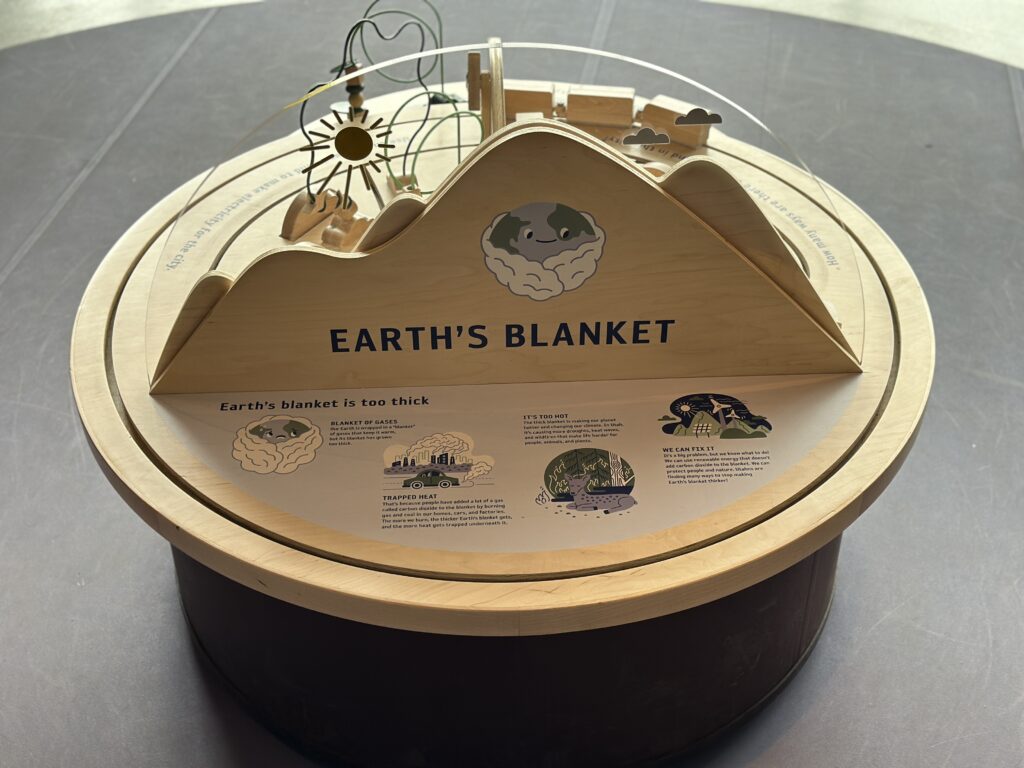
Lisa Thompson
Yeah. So, one of the things we heard from doing prototyping early on was that parents wanted information about how they could talk to their children about climate change. And so, we created this little area in the center of the exhibit that has a play table on it where kids can gather and just, you know, do all kinds of fun things in a sustainable city with blocks and beads that move around and things that you can turn and slide. But on the tables next to the benches where parents can sit, there’s little booklets that parents can pick up and read that talk about developmentally appropriate strategies for talking to their kids about climate change. We don’t expect them to do it like right here and now, and they exhibit that they’ll just have these things in their minds when they’re ready to have that conversation. And there’s a QR code that you can scan, so you can take a digital version of the booklets home with you. And then the table also contains a really simple metaphor about explaining kind of how climate change works are what’s happening about Earth’s blanket of gases being too thick, and that it’s making things too hot, but that adults know what to do and that they’re taking action and that a brighter future is possible.
Ross Chambless
That’s a really interesting metaphor, too, and I’m sure that’s very helpful for a lot of parents to provide that sort of input, as far as how to talk about it. Yeah, that’s very interesting. So, where else where else are we headed here? On to this site.
Lisa Thompson
We can talk quickly about this section here is called Building Momentum. And this is where we really get into solutions. So, one of the things when we talk to visitors early on I mentioned, they said they didn’t know if there was any there were any solutions available even at all. And so, in this section, we highlight all of the projects around the state… well, as many as we could… where the people are implementing technologically feasible, economically beneficial solutions for the state. So, there’s a big emphasis on clean energy, a map that’s highlighting the 30 utilities scale renewable energy projects that are already up and running in the state. The fact that Utah has incredibly rich renewable energy, renewable energy resources and can continue to be an energy powerhouse in this new renewable energy future. And another section, because we need to take many paths all at once toward a sustainable future that highlight other actions that are underway in communities across the state, from looking at agriculture to addressing food waste, you know, to thinking about bringing energy to communities that haven’t had it before. Hopefully we visitors will find something there that resonates with them.
Ross Chambless
Yeah, absolutely. I think that’s definitely an effective approach is just to talk about everything that is happening already. I think there’s probably not a lot is known as far as what kinds of solutions are in the works. I think we recognize that every day, even at the Wilkes Center, even though we’re surrounded by solutions, that a lot of folks don’t necessarily realize the scope of everything that’s happening.
How did you go about identifying those various projects or groups or activities happening? I guess my question is, as far as building out this exhibit and planning for it, it seems like it must have taken a lot of time and research to put this all together, right?
Lisa Thompson
Yeah, we started work on it in early 2020, just before the pandemic hit, was when we did our first evaluation with visitors to find out what they were interested in learning about in a climate change exhibit. But for me, the most gratifying part of the exhibit was to reach out to different people. And, you know, it would be one person would tell me, oh, you should talk to these people over there. And they would refer me to something to someone else. But just to see how much is happening in every corner of the state, how many young, passionate, dedicated people there are out there who are coming from all different angles to work on climate solutions.
Ross Chambless
Lynne, anything to add to that?
Lynne Zummo
Well, just I think this section hits on a really key idea of the exhibit and a key frame that underlies the exhibit, which is in the past and in previous exhibits about climate change elsewhere, and even in education about climate change, the message has sounded something like we need to do all these things now to avoid catastrophe because catastrophe is coming. But research and communication show that that’s really not an effective way of framing this, and it doesn’t engage people who are already engaged on the issue. So, we’ve really attempted to reframe by emphasizing that the actions that we take now can actually give us a better future. It can give us a better world than we have right now. It can give us cleaner air, it can give us more affordable, more plentiful energy, more walkable, equitable communities. So that’s the frame that I think is one thing that makes this exhibit different than other exhibits and that gives it real potential to reach a wider audience.
Ross Chambless
Interesting. Margaret, anything to add from your observations?
Margaret Call
Well, I think like while I was doing the training for the gallery interpreters and learning about all of the different things, and we got we got briefed on the basics of the climate science and everything while we were learning how to talk about climate change. But I think that this was my favorite part of learning about the exhibit because I think I studied geology and climate science. And so, we spend a lot of time and work on how it’s going and how it’s going to end and all these things. And I am not in engineering or anything. So oftentimes we don’t get to solutions. We just talk about the science behind it. And so, kind of working with the exhibit was my first exposure really to talking about solutions here at Utah and taking kind of a solutions-based perspective about talking about climate in general. And so, I think that as an interpreter or gallery interpreter interacting with the guests, that’s been really powerful for me to be able to sit here and like, like both learn about solutions, but talk to people about solutions and kind of take that perspective has been really cool. Both as a guest and as a volunteer.
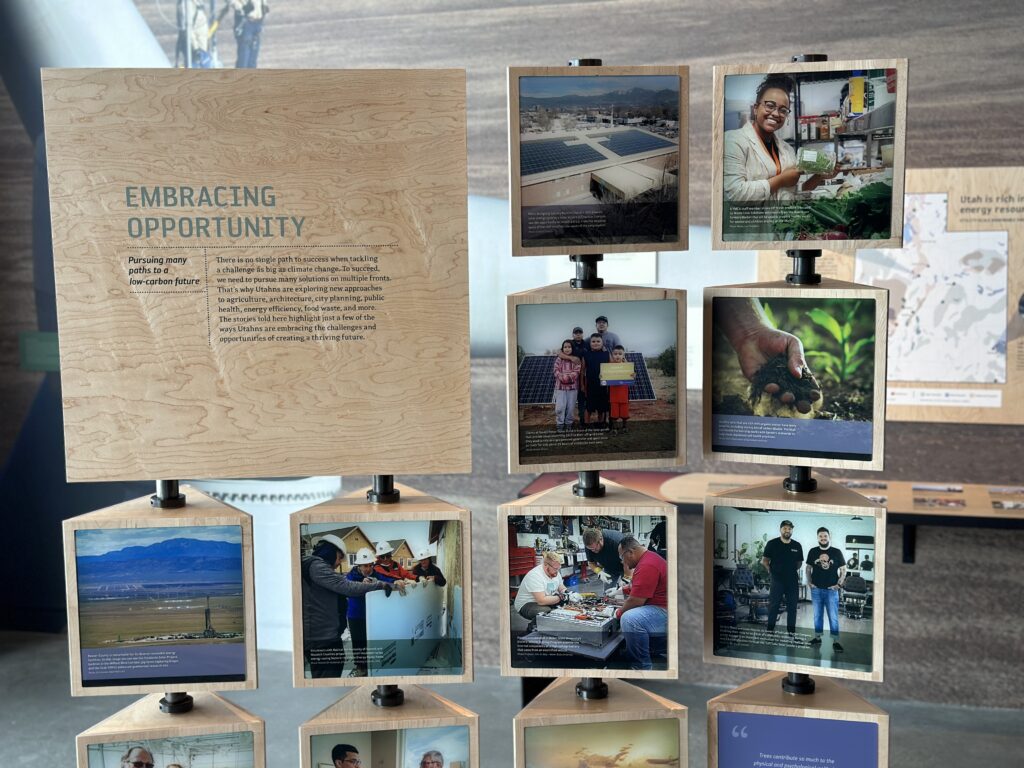
Ross Chambless
Yeah. Thanks. I’ll also say I really love just the positioning of this exhibit where you can look out and see this beautiful view of the valley and kind of see the bigger picture that way too and put that in context. It’s a nice location. Should we move on further down this way?
Well, I am very interested in sort of the area of the field of climate communication as far as figuring out what is effective communication in this area. And I know it’s probably continually something that is being built upon and we’re learning new and more things about what is effective and what is not effective. And it does seem like as far as just generally, as someone who’s observed this issue for a while, people talk about it very differently than they did even like ten years ago. So, it’s really interesting to see that put to work here in this exhibit.
Lynne Zummo
I’m glad that you see that. And I completely agree that how people are starting to talk about the climate feels different and it feels less catastrophic and more in line with that framing of the better future and what’s the future that we want and what do we have to do now to make sure we reach that?
Ross Chambless
Yeah. And so I was also curious to ask as far as gathering data and getting experience from this exhibit, how do you think that what we’re learning here might be useful down the road as far as moving it actually beyond the museum setting into more the public sphere, the policymaking sphere, do you think there’s going to be lessons learned that could be useful for that?
Lynne Zummo
I’m yes, and I’m very hopeful about that because it’s one thing if we can do something great and interesting here and enrich our visitors here. But I think we also, with this exhibit, the way it’s set up and the way it’s been developed and designed, and the research that we have on this, if the research comes out and says something interesting, there’s opportunity to take these takeaways elsewhere to other museums, to other educational spaces. I work in the formal education space as well, and I don’t think K-12 climate education is where it needs to be. So, I’m hopeful that there will be lessons from this exhibit that we could apply to schools and to curriculum and to communication more broadly. So, I have I have hope that there are lots of opportunities to apply what we learn here elsewhere.
Lisa Thompson
We’re already collaborating with a bunch of museums around the country. For example, the Oregon Museum of Science and Industry is using many of the interactives here as a base to begin building an exhibit on using this, our interactive as their prototypes to launch out and then build something that resonates with their community. We’ve been in discussions with the Smithsonian’s National Museum of Natural History. The California Academy of Sciences has reached out. And so, I think that many institutions are interested in taking a different approach toward climate change exhibits. And I think the Natural History Museum of Utah is on the leading edge of that. And so, we’re able to share out what we’ve done as a launchpad to help other people further explore the avenue that we’re on.
Ross Chambless
And this is a permanent exhibit, correct? And so, it’s probably something you could continue to build upon and improve as you go?
Lisa Thompson
Exactly. To me, it’s a permanent exhibit, but it is the least final exhibit in this building that I’ve ever worked on for several reasons. And there are sections, especially in the solutions portion of the exhibit, that are meant to be updatable because there are going to be so many inspiring projects that are coming online in the next few years that will want to be updating sections of that and elements of that section, I would say at least annually. And then as part of Lynne’s research work, we’ll have funding to remediate sections of the exhibit that aren’t working the way that we want to. So, after Lynne does her analysis, the exhibits team, in consultation with our partners at Heartland Community for Youth and Families and University of Neighborhood Partners, will begin to re-envision what sections of the exhibit could look like.
Ross Chambless
Okay. So, Lynne, as far as coming back to your research, how much longer do you anticipate collecting data? And then what’s sort of your timeline as far as processing that and having some kind of report?
Lynne Zummo
It’s a great question. So, we’re planning to collect data for another month or so. And then our analysis will continue for a long time because there’s an enormous amount of data. But we should have some early results to hand off to the exhibits team within the next few months. So, the plan for this larger grant funded project is to pause data collection in a month, hand off results to the exhibits team so they can spend a year or so working through those results and in partnership with Heartland Community for Youth and Families and University Neighborhood Partners. To come up with some ways to re-envision parts of the exhibit. And then we’ll do another round of data collection in in two years or so. So, it’ll be an ongoing process and I think there’s going to be a lot that comes from this.
Ross Chambless
Yeah. Well, very exciting. Maybe we’ll have to meet up again once you have your data out and we can kind of go through what you’ve learned and how that might shape the exhibit and also what lessons we can learn as far as going forward with it.
Lisa Thompson
Oh, don’t you want to hear Lynne’s exciting preliminary results?
Ross Chambless
Yeah, absolutely. Yeah. If you’re if you’re okay to share?
Lynne Zummo
Sure. Well, we should probably step over to the final part of the exhibit, which we call Imagining the Future. And it’s an interactive with a large screen and different objects. And if you press one of those buttons, you can see what happens.
Ross Chambless
OK, should I go over and push? Okay, I see a bike helmet and a button next to it and I’m going to push it. And…
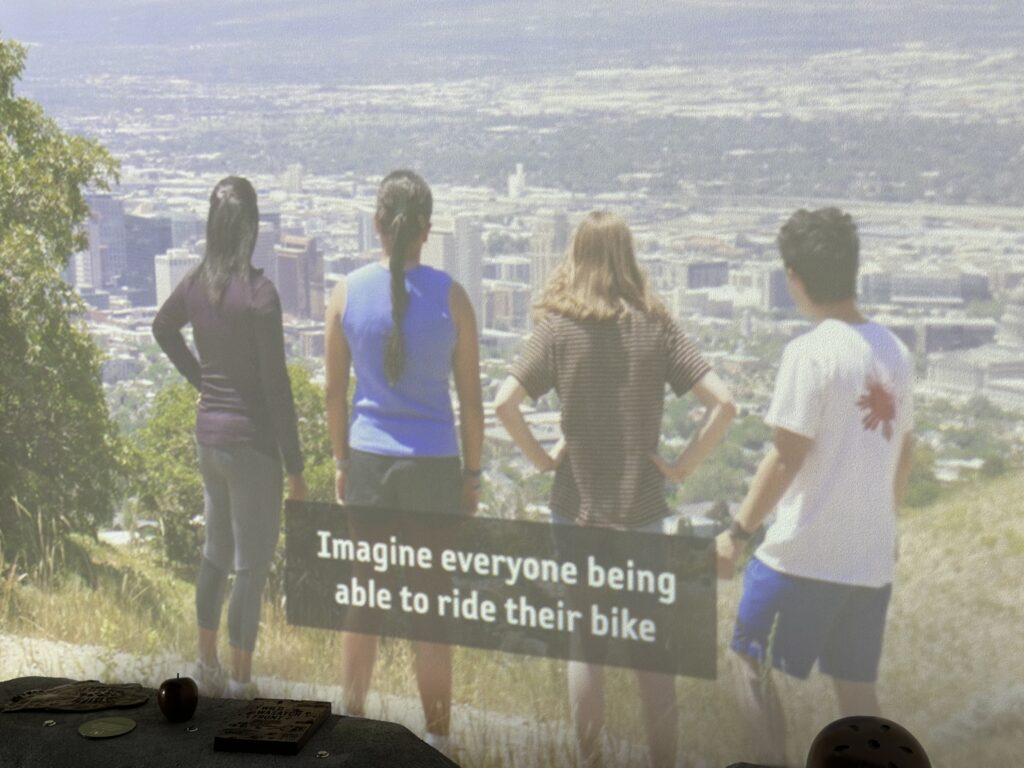
[Exhibit Audio]
Did you see that new bike path that connects to this trail?
Yeah, we should ride our bikes up here next time.
That sounds like a lot of work. Maybe if I had an electric bike.
I wish there were more ways to get to the trailhead. I’d like to be able to take a bus someday.
Especially if it were an electric bus.
I’d still like to drive, but hopefully we’ll have transportation options soon.
Yeah, if people have more options for getting places that would really help reduce traffic congestion.
It would probably be cheaper too.
Yeah, we can have more places for walking and biking. Imagine everyone being able to ride their bikes safely all over the city.
And just think of all the clean air we’d all be breathing without all that car exhaust.
I’m imagining throwing away my inhaler. Here’s what I know. We get up early, hop on a high-speed train to St George and we’re hiking in the red rocks by the afternoon.
I’m definitely on that train.
Ross Chambless
That was interesting. So, seeing a group of kids on the hillside overseeing the valley and you just heard that conversation. Tell me about that. How did that come together?
Lynne Zummo
Yeah, well, Lisa can tell you more about how it came together, but I can tell you a little bit about what we’re seeing in response to it. So, this is part of the exhibit that to me really speaks to that framing of a better future, that if we take certain actions now, we could have this world that is just wonderful and amazing to live in. You know, we can hop on a high-speed train to St George and be there in the afternoon.
So, what we’re seeing is that this interactive in particular does a really effective job of engaging people across a wide range of incoming views about climate change. So even those visitors who might not be on board with talking about climate change on a day-to-day basis or are just uncertain of it, this part of the exhibit really seems to engage them and make them curious and promote talk about solutions and solutions that that exist and could exists. Whereas some other parts of the exhibit that also have this better future framing, maybe trigger more ideas about how solutions are impractical or unlikely for those visitors who come in with more negative views of climate change originally.
So basically, we think there’s something special about this part of the exhibit in particular, and the next phase of research is going to dive into that a bit more.
Ross Chambless
Okay, that’s really interesting. And I have to say it’s exciting too, to hear about that. I think just the whole idea that we’re learning how to talk about this better and learn what’s more effective, and I know that has been an area, frankly, that has been really frustrating to a lot of people who have cared about this issue for a while. It’s like, how do you move the needle on getting people to care and to think about it? So that’s really exciting.
Lynne Zummo
Yeah, we think so. And we hope this finding, since this is the finding that came out of our prototyping that we did a year ago, we hope this finding continues with the actual exhibit. Now in the data that we’re collecting now.
Ross Chambless
Well, so Lynne Zummo and Lisa Thompson and Margaret, thank you so much for taking me through this exhibit and talking to us about Climate of Hope. And I guess we’ll put a plug in that anyone who hasn’t seen the exhibit yet should come and see it, right?
Lynne Zummo
Okay.
Lisa Thompson
Yeah. Come see us soon.
Related Articles:
https://nhmu.utah.edu/exhibitions/climate-of-hope
https://www.sltrib.com/amplify-utah/2024/03/24/utah-museums-climate-hope-exhibit/